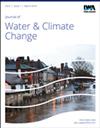普纳市土地利用的地球物理季节偏差、地形分析和水冷却对地表温度的影响
IF 3.1
4区 环境科学与生态学
Q2 WATER RESOURCES
引用次数: 0
摘要
城市热岛比农村更热。要实现城市的可持续发展和改善城市环境,就必须了解城市热岛(UHI)的成因,并找到有效的缓解技术。本研究以土地利用模式和水体降温为重点,考察了印度浦那地表温度的季节性偏差,以了解 UHI 效应。土地利用分类包括住宅、商业、工业、植被和空地。这项研究研究了冷却潜力以及与湖泊、河流和池塘等水体距离的温度差异。这些水体都有表面温度和环境温度传感器。道路、土壤、商业区、住宅区、工业区和植被都显示出 NDBI 的增加,幅度从 15.84% 到 36.45%。DEM 和等值线图显示了城市的热量积聚和散失区域。研究发现,水体对 350 米距离以内的 LST 有降温作用。研究发现了较热的地方,并通过分析土地利用模式和水体降温,展示了自然特征如何缓解 UHI。研究结果强调了绿地和水体在城市设计和发展中的重要性,以改善浦那的气候适应性和居住性。本文章由计算机程序翻译,如有差异,请以英文原文为准。
Geo-physical seasonal deviations of land use, terrain analysis, and water cooling effect on the surface temperature of Pune city
Urban heat islands are hotter than rural places. Sustainable urban growth and improving urban environments need understanding Urban Heat Island (UHI) causes and finding effective mitigation techniques. This research examines the seasonal deviations in surface temperatures for the UHI effect in Pune, India, focusing on land use patterns and water body cooling. Land use categorization included residential, commercial, industrial, vegetation, and open spaces. The research studied the cooling potential and temperature variance by distance from water bodies in the form of lakes, rivers, and ponds. These aquatic bodies have surface and ambient temperature sensors. Roads, soil, commercial areas, residential areas, industrial areas, and vegetation have all shown increases in NDBI, ranging from 15.84 to 36.45%. Urban regions with heat accumulation and dissipation have been revealed by DEM and contour maps. The research found that the water bodies have a cooling effect on LST till the distance of 350 m. The research finds hotter places and shows how natural features mitigate UHI by analyzing land use patterns and water body cooling. The findings emphasize the significance of green areas and water bodies in urban design and development to improve Pune's climate resilience and inhabitability.
求助全文
通过发布文献求助,成功后即可免费获取论文全文。
去求助
来源期刊

Journal of Water and Climate Change
WATER RESOURCES-
CiteScore
4.80
自引率
10.70%
发文量
168
审稿时长
>12 weeks
期刊介绍:
Journal of Water and Climate Change publishes refereed research and practitioner papers on all aspects of water science, technology, management and innovation in response to climate change, with emphasis on reduction of energy usage.
 求助内容:
求助内容: 应助结果提醒方式:
应助结果提醒方式:


